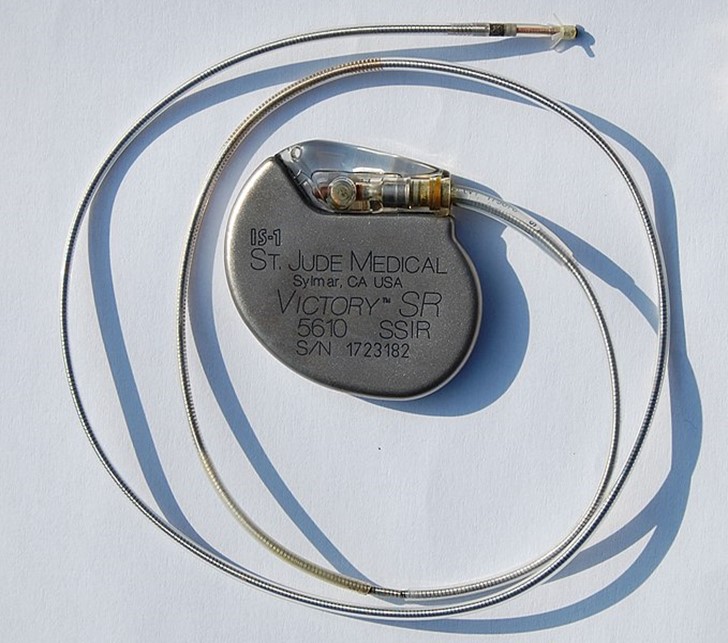
I learned this today. A pacemaker works by using electrical stimulation to make the heart muscles contract and the heart pump blood.
A pacemaker is used to alter the rhythm of a heart. It is usually implanted to help with a slow or an irregular heartbeat. There are many reasons why a heartbeat could become irregular. Some of these could be old age, side effect of medication, damage after a heart attack, or genetic conditions.
The heart has two sides separated by a thin muscular wall called a septum. Each side of the heart has an upper chamber and a lower chamber. The upper chamber is called the atrium (left and right), and the lower chamber is called the ventricle (left and right). Low-oxygen blood flows into the right atrium. The right atrium pumps the blood to the right ventricle where it is pumped on to the lungs. The blood is oxygenated in the lungs and flows back to the heart, entering the left atrium. The left atrium pumps it to the left ventricle, which then pumps it on to the rest of the body.
The heart muscle has three layers. The outer layer is called the pericardium and its job is to protect the heart. The next layer is the myocardium. This is the muscle that contracts and relaxes to make the heart pump. A heart attack is technically known as a myocardial infarction because it happens when the myocardium layer stops working. The inner layer is called the endocardium and it lines the heart.
A normal heart is controlled by a natural pacemaker, and it beats roughly once a second, depending on how fit you are, or the amount you exert yourself throughout the day. The natural pacemaker is located in the sinus node of the heart, which is in the wall of the right atrium of the heart. The sinus node is filled with cardiac muscle cells whose job is to make the heart muscle contract. They do this with electrical stimulation. Charged atoms move across the cell until an electrical potential is built up. This discharges across the heart muscle, causing it to contract. Problems with heartbeat rhythm tend to stem from these cells. A pacemaker’s job is to replace these cells and make the heart beat with an artificial current.
There are three basic types of artificial pacemaker. A single chamber pacemaker, which is usually just for the right ventricle. A dual chamber pacemaker, which works on the right ventricle and atrium. And a biventricular pacemaker which stimulates the entire heart.
A pacemaker is implanted into the chest and connected to the heart with an electrode. It sends an electrical signal to the heart to make it contract. They usually have a sensor to detect the heart’s own beat and they only fire when the heartbeat is too slow. The device also contains a battery that lasts between five to ten years. Modern pacemakers also have sensors that can detect body motion and breathing rate, increasing the heartbeat to the required level.
Experiments with electricity on the human heart began in 1889 and continued throughout the first half of the twentieth century. In 1958, the first pacemaker was implanted in a human. It weighed 45kg and was powered by a 12 volt battery. The patient lived for 10 months. The invention of silicon transistors and lithium batteries helped reduce the pacemakers in size and improve their reliability. By the 1970s, the batteries could last for up to 10 years. A modern pacemaker is about 5cm by 4cm and weighs 50g. They are becoming smaller and a pacemaker the size of a pill is currently being tested.
Currently, 3 million people worldwide use a pacemaker so there is a lot of initiative to make them smaller and better. Leadless pacemakers that can be implanted directly into the heart wall are entering the market. Pacemakers that generate their own power are also undergoing research. One idea is to use piezoelectric energy generated by the movement of the internal organs, which would reduce the need for battery replacement surgery.
The end goal for pacemakers appears to be biological or genetic pacemakers. This would mean, in essence, replacing the faulty part of the heart with working cells. Or, in perhaps ten years, replacing the whole heart with an artificial one. Using stem cells harvested from the person’s own body would reduce rejection and life after a heart attack could become possible.
So, pacemakers are used to adjust the electrical signal that makes the heart beat. They have grown smaller and more advanced over the years. And this is what I learned today.
Photo By Steven Fruitsmaak – self-made, removed from a deceased patient before cremation., CC BY 3.0, https://commons.wikimedia.org/w/index.php?curid=2909069
Sources:
https://www.mayoclinic.org/tests-procedures/pacemaker/about/pac-20384689
https://en.wikipedia.org/wiki/Artificial_cardiac_pacemaker
https://en.wikipedia.org/wiki/Cardiac_pacemaker
https://en.wikipedia.org/wiki/Cardiac_pacemaker
https://www.bhf.org.uk/informationsupport/how-a-healthy-heart-works
https://www.heart.org/en/health-topics/arrhythmia/prevention–treatment-of-arrhythmia/pacemaker
